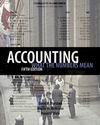 |  Accounting: What the Numbers Mean, 5/e David H. Marshall,
Millikin University
Wayne W. McManus,
International College of the Cayman Islands
Daniel F. Viele,
Webster University
Managerial Accounting and Cost-Volume-Profit Relationships
Chapter 12 Learning ObjectivesAfter studying this chapter, you should understand:
1.The managerial planning and control cycle. |
 |  |  | 2.The major differences between financial accounting and managerial accounting. |
 |  |  | 3.The difference between variable and fixed cost behavior patterns, and the simplifying assumptions made in this classification method. |
 |  |  | 4.Why expressing fixed costs on a per unit of activity basis is misleading and may result in faulty decisions. |
 |  |  | 5.What kinds of costs are likely to have a variable cost behavior pattern and what kinds of costs are likely to have a fixed cost behavior pattern. |
 |  |  | 6.How to use the high-low method to determine the cost formula for a cost that has a mixed behavior pattern. |
 |  |  | 7.The difference between the traditional income statement format and the contribution margin income statement format. |
 |  |  | 8.The importance of using the contribution margin format to analyze the impact of cost and sales volume changes on operating income. |
 |  |  | 9.How the contribution margin ratio is calculated and how it can be used in CVP analysis. |
 |  |  | 10.How changes in sales mix can affect projections using CVP analysis. |
 |  |  | 11.The meaning and significance of the break-even point and how the break-even point is calculated. |
 |  |  | 12.The concept of operating leverage. |
|


 2002 McGraw-Hill Higher Education
2002 McGraw-Hill Higher Education